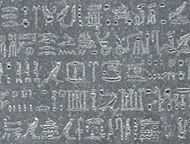N-red crown (n hieroglyph)
| ||
| 1 Red Crown, Deshret 2 also, vertical "N" in hieroglyphs | ||
|---|---|---|
The ancient Egyptian Red Crown, the Deshret crown, is one of the oldest Egyptian hieroglyphs. As an iconographic element, it is used on the famous Narmer Palette of Pharaoh Narmer as the "Red Crown of the Delta", the Delta being Lower Egypt.
| |
Language usage of vertical "n"-the Red Crown
| ||||
| Deshret, Red Crown (crown as determinative) in hieroglyphs | ||||
|---|---|---|---|---|
The first usage of the Red Crown was in iconography as the symbol for Lower Egypt with the Nile Delta. Later it came to be used in the Egyptian language – as an alphabetic uniliteral, vertical form for letter "n" as a phoneme or preposition. It became functional in running hieroglyphic texts, where either the horizontal or vertical form preposition satisfied space requirements.
The Red Crown is also used as a determinative, most notably in the word for deshret. It is also used in other words or names of gods.
One older use of the red crown hieroglyph is to make the word: 'in'!, (formerly an-(a-with dot)-(the "vertical feather" hieroglyph a, plus the red crown). Egyptian "in" is used at the beginning of a text and translates as: Behold!, or Lo!, and is an emphatic.
Rosetta Stone usage
In the 198 BC Rosetta Stone, the 'Red Crown' as hieroglyph has the usage mostly of the vertical form of the preposition "n". In running text, word endings are not always at the end of hieroglyph blocks; when they are at the end, a simple transition to start the next block is a vertical separater, in this case the preposition, vertical n, (thus a space saver).

Since the start of the next hieroglyphic block could also be started with a horizontal "n" at the bottom of the previous block, it should be thought that the vertical "n" is also chosen for a visual effect; in other words, it visually spreads out the running text of words, instead of piling horizontal prepositions in a more tight text. Visually it is also a hieroglyph that takes up more 'space'-(versus a straight-line type for the horizontal water ripple); so it may have a dual purpose of a less compact text, and a better segue-transition to the next words.
The Red Crown hieroglyph is used 35 times in the Rosetta Stone; only 4 times is it used as a non-preposition. It averages once per line usage in the 36 line Decree of Memphis (Ptolemy V)-(Rosetta Stone).
Iconography of the Red Crown
- For the main article of the Red Crown, see: Deshret

One of the first uses in iconography of the Red Crown is for Pharaoh Narmer, on his famous Narmer Palette. Throughout wall scenes, steles, tomb reliefs, papyrus, and representation of gods-as-pharaoh, either the Red Crown, White Crown, Pschent-crown, etc. are used.
A painted ostracon from the Ramesside Period is located in the Metropolitan Museum of Art. Ostracons were often used as a 'trial piece'; some ostracons were used as individual expressions-(like a cartoon), and their purpose, and usage often only guesswork.
The Egyptian hieroglyph alphabetic letters
The following two tables show the Egyptian uniliteral signs. (24 letters, but multiple use hieroglyphs)
a
|
i
|
y
|
'
|
(w,u)
|
B
| |||||||||||||
P
|
F
|
M
|
N
|
R
|
H1
| |||||||||||||
H2
|
Kh1
|
Kh2
|
S
|
(Sh)=Š
|
Q/K2
| |||||||||||||
K
|
G
|
T
|
Ch—Tj
|
D
|
Dj
| |||||||||||||
| L/(R) (special) (Ptolemaic, etc.)
|
-- | -- | -- | -- | -- |
| a | i (ee) |
y ii |
' ah, (aïn) |
w, (u) (oo) |
B | |||||||||||||||||
| P | F | M | N | R | H1 | |||||||||||||||||
| H2 | (Kh)1 | (Kh)2 | S | Sh (Sh) |
K emphatic | |||||||||||||||||
| K | G | T | Tj Ch Tsh |
D | Dj | |||||||||||||||||
| (additionally 4 for vert/horiz) |
-- | -- | -- | -- | -- | |||||||||||||||||
M (horiz) M2-Plinth |
N (vert) (see: N (red crown)) |
S (vert) S (folded) cloth) |
M (3rd-M -2nd-vert) M3-Baker's tool (vertical) | |||||||||||||||||||
| (additionally 3 for equivalents) |
-- | -- | -- | -- | -- | |||||||||||||||||
is—
y2-Two strokes |
is—
letter w, u (see w2-Coil) |
T (no. 2) T2-Pestle |
Vertical "n" gallery
-
Vertical N, with Reed: Egyptian language hieroglyphs, "behold!"
-
Another use of "Behold!"
5-columns read into the Kneeling Scribe, (read Column 5–4–3–2–1)
Column 2 starts: "Behold! the Kingdom's Scribe....." -
Apep being slain
Deshret headdress gallery
-
Ramesside Period ostracon, pharaoh wearing Red Crown
-
Narmer Palette, front
-
Close-up of Narmer Palette, Pharaoh Narmer with crown
See also
- Deshret, the Red Crown of the Pharaoh
- Gardiner's Sign List#S. Crowns, Dress, Staves, etc.
- Gardiner's Sign List
References
- Budge. An Egyptian Hieroglyphic Dictionary, E.A.Wallace Budge, (Dover Publications), c 1978, (c 1920), Dover edition, 1978. (In two volumes) (softcover, ISBN 0-486-23615-3)
- Budge. The Rosetta Stone, E.A.Wallace Budge, (Dover Publications), c 1929, Dover edition(unabridged), 1989. (softcover, ISBN 0-486-26163-8)







